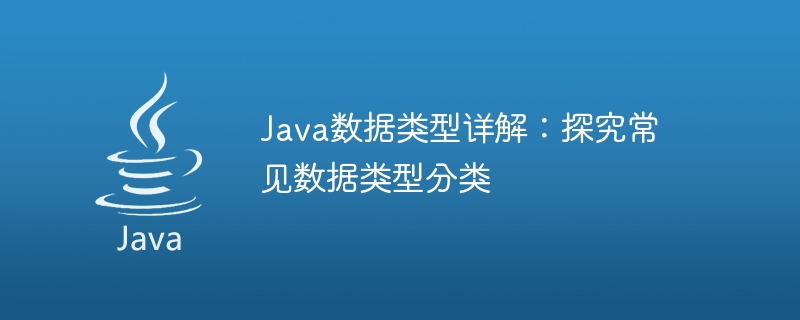Home >Java >javaTutorial >In-depth analysis of Java data types: research on common data type classification
In-depth analysis of Java data types: research on common data type classification
- WBOYWBOYWBOYWBOYWBOYWBOYWBOYWBOYWBOYWBOYWBOYWBOYWBOriginal
- 2024-02-18 12:44:061300browse

Detailed explanation of Java data types: Exploring the classification of common data types
Introduction:
In Java, data types are one of the most basic concepts in programming. It is important to understand and use the correct data types because they determine the range of values that a variable can store and how much memory space it takes up. This article will introduce common data types and their classification in Java in detail, and provide corresponding code examples to help readers better understand and apply these data types.
1. Data type classification
Java data types can be divided into two categories: basic data types and reference data types.
- Basic data types
Basic data types in Java are data types used to declare simple variables. The sizes of basic data types are fixed and are not affected by the operating system. Java provides eight basic data types, namely: integer type (byte, short, int, long), floating point type (float, double), character type (char) and Boolean type (boolean).
- Integer type (byte, short, int, long):
Integer data type is used to represent integer values. Their value range and memory size are as follows:
byte: The value range is -128 to 127, occupying 1 byte of memory.
short: The value range is -32,768 to 32,767, occupying 2 bytes of memory.
int: The value range is -2,147,483,648 to 2,147,483,647, occupying 4 bytes of memory.
long: The value range is -9,223,372,036,854,775,808 to 9,223,372,036,854,775,807, occupying 8 bytes of memory.
Sample code:
byte num1 = 100; short num2 = 1000; int num3 = 100000; long num4 = 1000000000L;
- Floating point type (float, double):
Floating point data type is used to represent decimal values. Their value range and memory size are as follows:
float: The value range is 1.4E-45 to 3.4028235E38, occupying 4 bytes of memory.
double: The value range is 4.9E-324 to 1.7976931348623157E308, occupying 8 bytes of memory.
Sample code:
float num1 = 3.14f; double num2 = 3.1415926;
- Character type (char):
Character data type is used to represent a single character. Its value range is 0 to 65535, occupying 2 bytes of memory.
Sample code:
char ch = 'A';
- Boolean:
Boolean data type is used to represent true or false. It has only two values: true and false. The Boolean data type occupies 1 byte of memory.
Sample code:
boolean flag = true;
- Reference data types
Reference data types refer to non-basic data types. They are usually used to store complex data structures, such as objects. , array, string, etc. The size of reference data types is not fixed, they only store addresses in memory, and the real data is stored elsewhere. Reference data types in Java include classes, interfaces, arrays, etc.
Sample code:
String str = "Hello World";
int[] nums = {1, 2, 3, 4, 5}; 2. Summary
This article introduces the classification of common data types in Java in detail and provides corresponding code examples. Basic data types include integers, floating point types, character types, and Boolean types, which are used to represent integers, decimals, characters, and true and false values respectively. Reference data types are non-basic data types used to store complex data structures. Understanding and correctly using these data types is very important for writing high-quality Java programs. Readers can deepen their understanding and practice based on the sample code provided in this article.
The above is the detailed content of In-depth analysis of Java data types: research on common data type classification. For more information, please follow other related articles on the PHP Chinese website!

